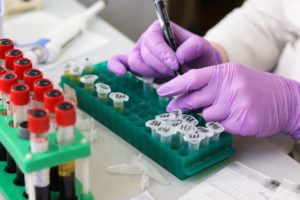
Year: 2020 and 2025
Market size: $1.9 billion and $4.1 billion, respectively
Metabolomics is the “comprehensive analysis of metabolites in biological specimens.”1 Metabolites are substances made when the body breaks down food, drugs, chemicals, or tissue (fat or muscle tissue, for example). These substances create energy and are needed for growth, reproduction, ridding the body of toxic substances, and maintaining health. The process for creating these substances is called metabolism. More than 9,400 metabolites have been detected by scientists to date, according to the Human Metabolome Database, but scientists believe that the human metabolome consists of more than a million compounds. Metabolomics is a relatively new field of study, only coming into existence in the late 1990s.
Scientists use metabolomics to research possible therapies for a variety of illnesses such as cancer, cardiovascular disorders, neurological disorders, and metabolic disorders. The increasing number of people with cancer and higher demand for cancer treatments account for the cancer segment having the largest market share in 2020. This segment of the industry is also expected to have the fastest growing revenues through 2025.
Today’s market size shows the total global revenues for the metabolomics market in 2020 and projected for 2025. Increasing research and development investment in the pharmaceutical and biopharmaceutical segment of the economy, especially at academic and research institutions, along with growing demand for personalized medicine will contribute to growth in this industry. The high costs of instruments and problems with data examination and processing, however, are likely to stifle some growth.2 Even so, the metabolomics instrument market accounted for the largest market share in 2020 as technological advancements, an increasing number of research-related activities, and the shoring up of healthcare infrastructure in developing countries contributed to demand.Thanks to technological advances, the metabolomics industry has been instrumental in biomarker discovery. Biomarkers are measurable substances in bodily fluids or tissue, the presence of which can be indicative of disease, infection, or environmental exposure. A biomarker can be used to test how well the body responds to treatments for a disease. As an example of biomarker research, George Washington University researchers are studying 5 biomarkers in the blood of those with COVID-19 to see if there is a correlation between having certain biomarkers and the severity of the disease. If there is a correlation, this could lead to a blood test to determine which patients will have a more severe form of the disease and will need to be monitored and/or hospitalized and which can be sent home for quarantining and bed rest.
By region, North America had the highest share of the market in 2020. Thirteen of the top 20 major corporations in the industry are located in the United States. These include Waters Corp., Agilent Technologies, Thermo Fisher Scientific, Danaher Corp., Bruker Corp., PerkinElmer, GE Healthcare, LECO Corp., Metabolon, Inc., Bio-Rad Laboratories, Scion Instruments, SRI Instruments, and JASCO Inc. Other major companies in this industry located elsewhere include Merck KGaA (Germany), Hitachi High Technologies Corp. (Japan), Human Metabolome Technologies Inc. (Japan), DANI Instruments S.p.A. (Italy), GL Sciences (Japan), and Kore Technologies Ltd. (United Kingdom). Revenues in the Asia-Pacific region are expected to grow the fastest through 2025. Several pharmaceutical companies have moved their research, development, and manufacturing operations to the region — especially to India and China where there are large numbers of qualified researchers — to tap into the growing market and to lower the costs of production.1 Clary B. Clish, “Metabolomics: An Emerging but Powerful Tool for Precision Medicine,” Cold Spring Harbor Molecular Case Studies, October 2015 available online here.
2 Unlike other omics where comprehensive data can be gathered using a single analytic platform, metabolomics relies on a combination of analytical platforms, each with its own advantages and disadvantages. As a result, laboratories have to have a variety of instruments available, each potentially costing in the hundreds of thousands of dollars. In addition, universal procedures for sample preparation, analysis, and interpretation of results are currently few or nonexistent.
Sources: “Metabolomics Market by Product, Application, Indication, End User – Global Forecast to 2025,” ReportLinker Summary, December 2020 available online here; Clary B. Clish, “Metabolomics: An Emerging but Powerful Tool for Precision Medicine,” Cold Spring Harbor Molecular Case Studies, October 2015 available online here; Farhana R. Pinu, et. al., “Translational Metabolomics: Current Challenges and Future Opportunities,” Metabolites, June 2019 available online here; “The Global Metabolomics Market Size is Projected to Reach USD 4.1 Billion by 2025 from USD 1.9 Billion in 2020, at a CAGR of 13.4%,” GlobeNewswire, December 24, 2020 available online here; David S. Wishart, “Metabolomics for Investigating Physiological and Pathophysiological Processes,” Physiological Reviews, August 21, 2019 available online here; “The Human Metabolome Database,” The Metabolomics Innovation Centre available online here; “Blood Test May Point to Patients at Higher Risk for COVID-19 Deterioration, Death,” George Washington School of Medicine and Health Sciences Press Release, August 5, 2020 available online here; Max Roser and Hannah Ritchie, “Cancer,” Our World in Data, July 2015, Revised November 2019 available online here; “Metabolite,” NCI Dictionary of Cancer Terms available online here; “Biomarker,” NCI Dictionary of Cancer Terms available online here.
Image source: Belova59, “laboratory-medical-medicine-hand-3827745,” PIxabay, November 25, 2018 available online here.
